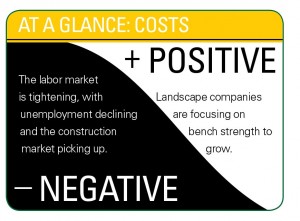As the labor market tightens, landscape contractors continue to struggle to fill key positions.
GreenSeasons, a full-service landscape company in Baton Rouge, La., “just cannot get steady workers,” owner Chris Casselberry says.
The company’s annual revenue for 2012 was $7 million, and it expects to be up about $100,000 in 2013. “We could have done better, but we aren’t really pushing too hard because we don’t have the labor force,” he says. Casselberry is not alone.
“Finding good people is the biggest obstacle,” says Dan Dahlkemper of Dahlkemper Landscape Architects & Contractors in Erie, Pa.
Labor is “hands down” the No. 1 thing that hinders growth for the landscape division of Potomac Garden Center in Urbana, Md., says Matt Owens, vice president of landscape operations.
“Staffing is absolutely our biggest hurdle to growth,” says Andrew Ziehler, owner of Ziehler Lawn & Tree Care in Centerville, Ohio.
With the unemployment decreasing and construction market picking up nationwide, the landscape labor pool likely will get even tighter, says consultant Bruce Wilson of the Wilson-Oyler Group.
“Contractors are worried about labor costs going up,” he says.
Why do these companies have such trouble finding workers? Most Green Industry professionals have a similar story to tell. To start, people don’t have a positive view about working in the Green Industry, Casselberry says. Plus, it’s hard work.
“If you feel the heat we work in, most people come in and say, ‘Oh, I can’t do that kind of work,’” he says. “Most Americans don’t raise their kids to go work outside all day. Now kids play electronic games and they go to college.”
To battle these obstacles, Casselberry’s company offers benefits and gives bonuses to people who bring in workers. The company also works with a state labor program and calls charities and churches looking for people who are unemployed. Additionally, GreenSeasons uses the H-2B guest-worker visa program for about half of its workforce, which is a challenge of its own.
In fact, if the government forces the company to raise its wages for H-2B workers next year from the $11 per hour it currently pays them, he may be forced to make cuts. Under the new wage methodology for the H-2B program, some landscape companies report they will be required to institute mandatory wages increases by as much as 30 percent. GreenSeasons employs 60 H-2B workers—about half of its total workforce. “We haven’t decided yet, but we may downsize,” he says. “You can’t cut grass with nobody running the trucks.”
Matt Owens, vice president of landscape operations for Potomac Garden Center in Urbana, Md., says the Department of Labor has notified his company that it’s required to increase H-2B wages 31 percent next year. The company has about 30 H-2B workers.
“We’re appealing it, but we’re also escrowing the money,” he says. “We’re hoping we’ll win the appeal, but it may force us out the H-2B game.”
Attracting and retaining
Ziehler, whose company is primarily lawn care and some maintenance, says finding people who can provide the company’s level of quality is very difficult.
“We’re having a heck of a time trying to find the right people to bring on board,” he says. “(It’s tough) trying to get those good candidates in the door.”
One way he’s addressed this challenge is by focusing on company culture and developing existing staff members through training programs to ensure retention is good. Still, getting new workers is a struggle—especially for a company that’s budgeted for 50 percent growth next year.
Beyond just finding enough workers to get the job done, Wilson says there’s a focus on building “bench strength” for growth.
“That hadn’t been the case for the past few years because nobody was really growing,” he says. “Now they see there could be a growth cycle ahead, so they’re thinking about bench strength so they have the ability to grow.”
Todd Pugh is an example of that. He is focusing on culture and attracting quality staff. Pugh previously used the H-2B program but today has an all-local labor force.
“Growing our people is the No. 1 focus of our company right now,” says Pugh, CEO of Todd’s Enviroscapes in Louisville, Ohio—an $11.5 million firm with about 175 employees. He hopes to grow 15 to
17 percent next year, and at such a large size, staffing up is the most difficult obstacle to hitting those figures.
“Adding 20 percent isn’t such a big deal when you have 10 people,” he says. “But at 200 people, you need 40 people to grow 20 percent.”
Attracting new employees is part of the challenge, as is making sure everyone already on board understands their opportunities, Pugh says. To convey that message, Pugh organized a day-long staff meeting with three speakers who addressed what it takes to achieve career success inside the landscape business or out.
“It was very well received,” he says, estimating it cost about $25,000 in payroll alone to host the meeting. “The big messages were nobody’s promotable unless you train your own replacement and nobody’s going to drag you through a career-training program. It’s up to you in your position to be looking for the next opportunity and go the extra mile.”
Additional reporting by Sarah Pfledderer.

